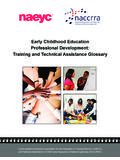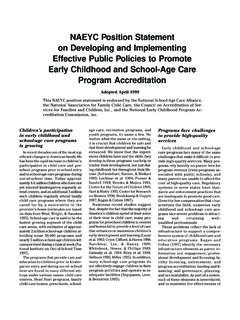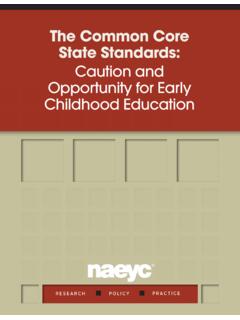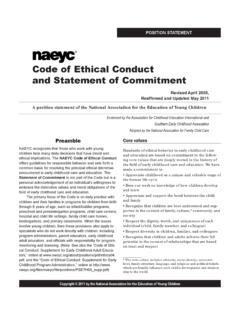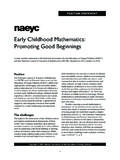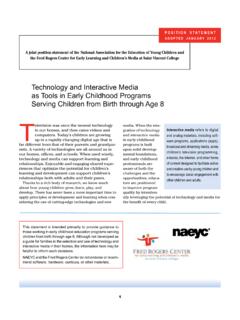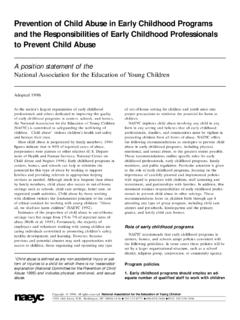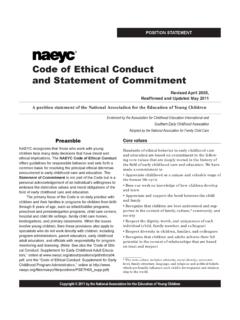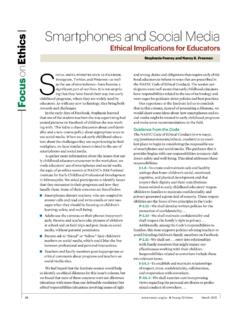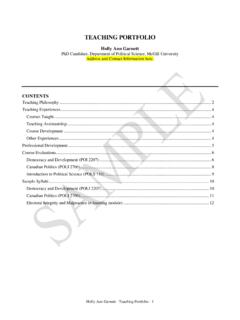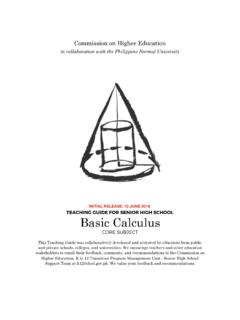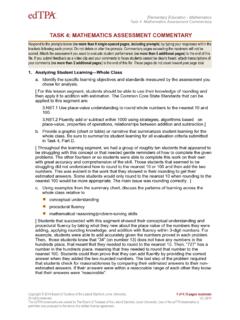Transcription of 2022 NEW OR REVISED MATERIAL IS FLAGGED ON ITEM …
1 Class portfolio Tool: All Ages NAEYC Site Visit Class portfolio Tool Page 1 of 15 Effective January 1, 2022 Copyright 2021. National Association for the Education of Young Children. All other rights reserved. 2022 NEW OR REVISED MATERIAL IS FLAGGED ON ITEM HEADER. Revisions are shown in bold font. Program ID#: Org. ID#: Visit Date: MM/DD/YYYY Assessor ID#: Assessor Last Name: Class portfolio Review Time Start Time: hh:mm AM/PM End Time: hh:mm AM/PM Age category(s) of children in this CP: Infant Toddler/Two Preschool Kindergarten School-Age Class(es) in this CP: Class Name: Class Number: Class Name: Class Number: Class Name: Class Number: Class Name: Class Number: Reliability Check: Yes No General Rating Guidelines: Example(s).
2 A specific, concrete instance of the practice, as opposed to a general statement of how the practice is done. Lesson plan: Broadly defined as a guide for teaching staff to implement learning activities and opportunities. Lesson plan evidence may take the form of written daily, weekly or monthly documents containing brief descriptions of multiple planned activities; detailed plans (Usually a page or two) for a single activity; or curriculum webbing. Play: Children's active engagement and enjoyment of an activity and their ability to determine how the activity is carried out.
3 Show or describe: When an item says "show or describe", this means that you may document the stated practice with a sample (photo, captioned photo, child work sample, form, lesson plan) OR provide a brief narrative description ( paragraph) that specifically addresses how you meet the stated practice. It is acceptable to both show AND describe, if both are needed to adequately address the stated practice. Skill: The ability to do something well, usually as the result of training and practice. Examples of skills: Tooth brushing, assembling a puzzle, putting on a coat, holding a pencil, adding, riding a tricycle, measuring and pouring.
4 Class portfolio Tool: All Ages NAEYC Site Visit Class portfolio Tool Page 2 of 15 Effective January 1, 2022 Copyright 2021. National Association for the Education of Young Children. All other rights reserved. Standard 1 Relationships 1C: Helping Children Make Friends I T P K S Show or describe two examples of how you help make children's play more complex. Yes No 1D: Creating a Predictable, Consistent, and Harmonious Classroom I T P K S Show two objects, materials, or visual images within your classroom that depict men and/or women in work, family, and/or personal roles.
5 Yes No T P K S Show or describe one example of how children have opportunities to participate in decision making about class plans. Yes No Not Age T P K S Show or describe one example of how you have anticipated problematic behavior and taken steps to prevent it. Yes No Not Age Examples of problematic behavior: Temper tantrums, not following directions, persistent whining, conflicts with other children and adults. Standard 2 Curriculum 2A: Curriculum: Essential Characteristics I T P K S Show or describe two examples of how you change classroom materials or equipment as children s skill levels change over time.
6 Yes No T P K S Highlight and label two weeks of lesson plans to show where they include each of these content areas: literacy, mathematics, science, technology, creative expression and the arts, health and safety, social studies. Yes No Not Age Technology: Equipment and machinery developed from scientific knowledge. Examples of technology: Hand tools, microscopes, computers, clocks, keys, plumbing, wagons. Examples of social studies: Family, friends, community, social roles, social rules, geography, money, businesses, governments.
7 P K S Show or describe two examples of play experiences you have planned which are related to learning themes in the curriculum. Yes No Not Age Examples of curriculum themes or topics: Seasons, farm animals, transportation, insects. Class portfolio Tool: All Ages NAEYC Site Visit Class portfolio Tool Page 3 of 15 Effective January 1, 2022 Copyright 2021. National Association for the Education of Young Children. All other rights reserved. 2C: Areas of Development: Physical Development P K S Show or describe two examples of activities and materials that give children the chance to play physical games with rules and structure.
8 Yes No Not Age Examples of physical games with rules and structure: Hokey Pokey, Simon Says, Red Light/Green Light, hopscotch, tag. 2D: Areas of Development: Language Development P K S Show or describe two examples of how you teach children to have discussions with each other to resolve interpersonal problems. Yes No Not Age Interpersonal problems: Conflicts, disagreements, or misunderstandings between children or between children and staff. P K S Show or describe two examples of how you teach children to have discussions with each other to solve problems related to the physical world.
9 Yes No Not Age Examples of problems related to the physical world: How to retrieve a ball that has gone over a fence, using ramps to make cars go faster or further, putting puzzle pieces together. 2E: Curriculum Content Area for Cognitive Development: Early Literacy I T Show two examples of songs you sing to infants, toddlers, or twos during teacher-child one-on-one play. Yes No Not Age I T Show two examples of simple rhymes you share with infants, toddlers, or twos during teacher-child one-on-one play.
10 Yes No Not Age I Show two examples of interactive, routine games you share with infants during teacher-child one-on-one play. Yes No Not Age Examples of routine games: Patty-Cake, peek-a-boo, and Itsy-bitsy Spider. I T Show picture books, wordless books, and rhyming books (two or more of each) that are available to infants, toddlers, or twos every day. Yes No Not Age Wordless books: Books with no words or few words, in which information or narrative is conveyed primarily through imagery. Class portfolio Tool: All Ages NAEYC Site Visit Class portfolio Tool Page 4 of 15 Effective January 1, 2022 Copyright 2021.
